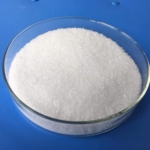Project Description
Sodium Acetate
Chemical Name: Sodium Acetate
Molecular Formula: C2H3NaO2 ; C2H3NaO2·3H2O
Molecular Weight: Anhydrous: 82.03; Trihydrate: 136.08
CAS: Anhydrous: 127-09-4; Trihydrate: 6131-90-4
INS No.: E262(i)
Character: Sodium Acetate Trihydrate is a colorless transparent crystal or white crystalline powder. The relative density is 1.45. In warm and dry air, it’ll easily get weathered. 1g sample could be dissolved in about 0.8 mL water or 19 mL ethanol.
Sodium Acetate Anhydrous: It is a white crystalline coarse powder or block. It’s odorless and tastes a bit vinegary. The relative density is 1.582. The melting point is 324℃. The capacity of moisture absorption is strong. 1g sample could be dissolved in 2 mL water.
Specification:
| Specification | GB 30603—2014 | FCC VII | |
|---|---|---|---|
| Content(As Dry Basis) | ≥98.5% | 99.0-101.0% | |
| Arsenic, As | ≤0.0003% | ≤0.0003% | |
| Mercury, Hg | ≤0.0001% | ≤0.0001% | |
| Lead, Pb | ≤0.0002% | ≤0.0002% | |
| Alkalinity | Anhydrous | ---- | ≤0.2% |
| Trihydrate | ---- | ≤0.05 | |
| Loss on Drying | Anhydrous | ≤2.0% | ≤1.0% |
| Trihydrate | 36.0-42.0% | 36.0-41.0% |
Application: Sodium acetate, a sodium salt of acetic acid, has several applications in food production. Here are some common uses:
1. In food processing:
- Flavor enhancer: Sodium acetate is a flavor enhancer, adding a slightly tangy and salty taste to food products. It is often used in snacks, condiments, sauces, and dressings to enhance flavor.
- pH regulator: Sodium acetate is used as a pH regulator and buffering agent in food production. It helps to maintain the desired acidity levels in various food formulations, ensuring consistent taste, texture, and quality.
- Preservation: It serves as a preservative in certain food products, inhibiting the growth of bacteria, yeast, and molds. By preventing spoilage, sodium acetate helps extend the shelf life of foods.
- Baked goods: Sodium acetate is used in baked goods like bread, cakes, and cookies. It helps regulate dough fermentation, improve texture, and enhance the volume and crumb structure of the final product.
- Dairy products: Sodium acetate can be added to cheese manufacturing processes in dairy production. It helps control pH levels during cheese formation, improves yield, and enhances the texture and flavor of the cheese.
2. In addition, Sodium acetate has several applications in other industries:
- Buffering agent: Sodium acetate is commonly used as a buffering agent in different chemical and biological processes. It helps maintain a stable pH and prevents drastic changes in acidity or alkalinity.
- Heat packs: Sodium acetate is used to produce reusable heat packs.
- Deicing agent: Sodium acetate is employed as a deicing agent for removing ice and snow from roads, runways, and sidewalks. It effectively lowers the freezing point of water, helping to melt ice and prevent buildup.
- Laboratory reagent: Sodium acetate is utilized as a common laboratory reagent. It is used in various chemical reactions, as a pH adjuster, and in preparing buffers for experimental procedures.
For more details, please visit this page Things about Sodium Acetate You Need to Know
Packing: In PP+PE bags of 25kgs net each, or according to customer’s requirement.
Storage: At a cool, dry, and well-ventilated place.
Hazards Identification & Classifications: N/A
Shelf life: 24 months.

